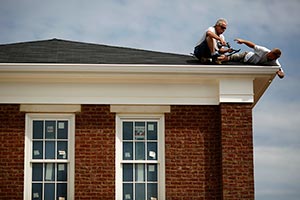Housing Starts Increase, Extending See-Saw Pattern

New-home construction rose in April, extending a pattern of gains and losses that signals the U.S. homebuilding industry is contributing little to economic growth.
Residential starts increased 6.6% to a 1.17 million annualized rate from 1.1 million in March, Commerce Department data showed May 17 in Washington. The median forecast of 79 economists surveyed by Bloomberg projected an increase to a 1.13 million rate. Permits, a proxy for future construction, also climbed.
The rebound in construction from the prior month’s slump keeps housing on a stable if uninspiring path as the world’s largest economy tries to move past disappointing first-quarter growth. While wages have been slow to pick up, prospects for further improvement in employment could sustain orders for new homes.
“This is a fairly volatile series,” said Gus Faucher, an economist at PNC Financial Services Group Inc. in Pittsburgh. “The general trend has been higher, and I think that’s what we’ll see through the rest of this year,” amid low mortgage rates, steady job growth, rising wages, and pent-up demand, he said.
Economist estimates in the Bloomberg survey ranged from 1.05 million to 1.2 million. The March figure was previously reported as a 1.09 million pace.
Figures for February were also revised up to a 1.21 million rate, matching the level of June 2015 as the strongest since late 2007, before the latest recession began.
The starts data, while very volatile from month to month, have held in a narrow range over the past year, indicating residential real estate will have trouble adding to its post-recession rebound.
Permits rose 3.6% to a 1.12 million annualized rate, indicating little scope for further gains in starts. They were projected to rise to 1.14 million. The March reading in applications was 1.08 million.
Construction of single-family houses climbed 3.3% to a 778,000 rate from 753,000 in March.
Groundbreaking on multifamily homes, such as townhouses and apartment buildings, increased 13.9% to an annual rate of 394,000, the most this year. Data on these projects, which typically have led housing starts over the past few years, can be especially volatile.
Starts rose in two of four regions, led by a 22.2% jump in the Midwest. They also rose in the South and declined in the Northeast and West.

